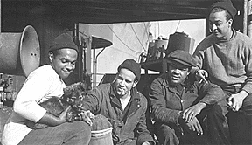I also have many friends who shared stories of staying down south, or in the country surrounded by tons of cousins in the summertime. These trips were mainly because they were out of school and relatives were the trusted resource for childcare. Children were supervised, and consequently not getting into mischief, nor running the air conditioner all day long and eating up all the food.
 |
| heleenvandeven.wordpress.com |
Fresh, home-cooked food was always featured in my friends' "down south" stories, along with tales of outdoor games, cook-outs and family reunions. Friends would unconsciously slip into an Alabama, Georgia, or Carolina accent when discussing their relatives and the great time that they had visiting. On the few occasions when I traveled to the south as a youngster, kids would remark, "Where is Connecticut?", or "You talk so proper."
My father lived with his maternal grandparents in Tampa, Florida. It was after directly after the "Dad Causes His Family To Get Fired" incident. At one time his entire family lived with his grandparents after the Primus Family job dismissal. Eventually, the family secured employment in Daytona Beach, FL. Dad remained with his grandparents and an aunt in Tampa. He indicated that he was close in age to his younger brother Ted and that times "were rough during the Great Depression." One less mouth to feed would be easier.
Dad explained he was spoiled by his grandparents. His grandfather was Z.K. Rose, an African Methodist Episcopal minister who had his own church. The Rose family lived in a parsonage. Pastor Rose was given milk, sweet potatoes and "a few quarters thrown in the cigar box" by grateful church members. My father accompanied him on some of his ministerial trips. The presiding elder would pay dad's grandfather once a month. His other job was working in a phosphate mine in Floral City, Florida.
 |
| Source: 4BP.blogspot.com One of my father's candies of choice. Named after New York Yankee Babe Ruth. |
After some time, Dad moved to Daytona Beach, Florida and lived with his parents and brothers and sisters. He attended Bonner Elementary School there. His grandparents and his aunt regularly sent him money. Dad's pockets were always jingling with nickles and dimes. Additionally, he would eat Baby Ruth and Goodbar chocolate candy bars in front of his siblings and refused to share. I guess this is where the "spoiled rotten" part comes into play.
As a teenager Dad worked at Hubert's Pharmacy and Harry's grocery store. He swept and arranged items in the stores, and loaded the car for delivery. Obviously, few people owned cars. Dad delivered groceries on his bike. He was also a newspaper carrier and had educator and civil rights icon Mary McLeod Bethune on his paper route.
Apparently, Dad was a hard worker as a juvenile. And that spoiled rotten part? He eventually outgrew that phase and made ultimate sacrifices for his country and family. A true Marine.
Notes: Frantz Fanon (1925-1961) is a Martinique born, French writer, psychiatrist and activist. He is famous for his books, White Masks, Black Skin and The Wretched of the Earth. Fanon became involved in the movement to free Algeria from French colonialism. He has had a profound effect on post-colonial discourse and leaders.
*"Chicken in a pot every Sunday" was originally attributed to Henry IV of France, when speaking about peasants during the 17th century.
**African Methodist Episcopal Church-Was the first major religious denomination in the Western World that had its origin over sociological and theological beliefs and differences. It rejected the negative theological interpretations which rendered persons of African descent second class citizens. Its founder was the Reverend Richard Allen of Philadelphia, PA in 1816. Allen and other leaders left St. George's Methodist Episcopal Church because of discrimination. From www.amechurch.org
***Phosphate is a mineral that is mined. In north America it can be found in central Florida. Plants need phosphates to stimulate healthy root development. Phosphates are used it in food, and in industrial detergents, acts as a anti-corrosion agent, plus a myriad of other uses.

































